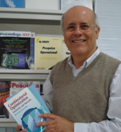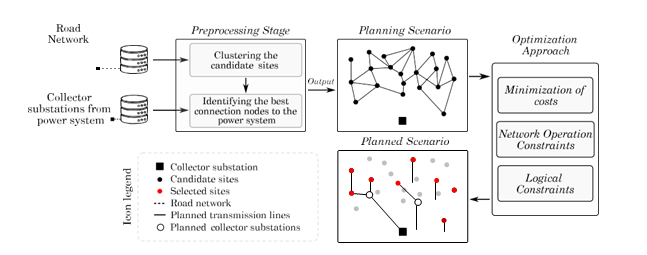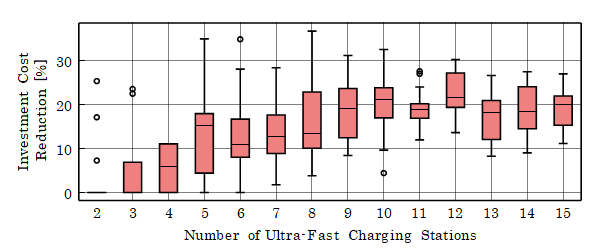Integration Network Planning to Connect Public Ultra-Fast Charging Stations into the Power Systems
Written by Caio dos Santos, José C. G. Andrade, and Christiano Lyra Filho
Public ultra-fast charging station (with hundreds of kilowatts) infrastructures of electric vehicles (EVs) are the future and the consolidation of electromobility worldwide. The use of these technologies allows batteries to be recharged in a few minutes and brings the EV owner closer to the dynamism of refueling vehicles with combustion engines. On the brink of expansion of public charging stations with greater recharging active power, new challenges are emerging in the planning stage, such as the designing an efficient integration network to connect public ultra-fast charging stations to the power system. This article champions the idea that there is an intrinsic synergy in considering the integration of all the public ultra-fast charging stations planned for a given road network. The benefits of adopting a suitable planning strategy are described through forecasts of reduced investment and operation costs.
The reintroduction of electric vehicles (EVs) is a promising technology in driving further flexibility for modern and sustainable cities, offering an efficient alternative to address fuel shortages and climate changes. In recent years, the rapid growth of EVs reinforced the search for new approaches to support the planning problems, such as:
- Where public charging stations (PCS) should be installed
- How many charging points each PCS should have
- What is the suitable nominal active power each charging point should have
Defining the PCS locations can be addressed by a broad outlook. From a power system perspective, the PCS allocation procedure should be based on the compromise between serving the EV owners and maintaining the distribution network state variables (i.e., voltage magnitudes and current flows) within the safe operation range; therefore, the models are usually designed to address the energy balance with the increase in demand for EV charging and point out (if required) the strategies to reinforce the feeders of the distribution network. Although this previous example describes a usual solution strategy from a power system perspective, the demands for recharging are strongly associated with the traffic flow of the local road networks through which the EVs should go; therefore, a quality solution should address the features of the road network and the power system.
As the need for public ultra-fast charging stations increases, the PCS allocation procedure that comprises different approaches for expanding the distribution network feeders might be limited to urban centers. This is a foreseeable limitation since, as you move away from urban centers, local distribution network feeders can be technically limited and with low reliability to aggregate large loads. In other scenarios, also far from urban centers, an access point to medium voltage distribution network feeders is unavailable. These assumptions should be usual when planning must satisfy the EV charging demand from road networks, which connect cities of a state or the entire country. In these cases, the ultra-fast charging infrastructures are directly connected to the nearest collector substations or any connection point to the bulk power system. Therefore, the PCS problem needs to include in its formulation the integration network planning, which comprises the planning of new collector substations, the voltage magnitude transformation ratio, and the voltage magnitude levels of the transmission network. Otherwise, the expansion of this type of EV charging station without proper planning can result in high-cost and low- performance infrastructure.
The optimization approach discussed here provides an efficient computation tool for the planning of an integration network to connect public ultra-fast charging stations to the power systems. Figure 1 illustrates the procedures designed for the computational tool. The computation tool is able to plan transmission lines, the collector substation allocation, and the voltage magnitude levels of the transmission line while ensuring the operational constraints of the network and the voltage magnitude at connection points with the power system. In this proposal, the collector substations play an important role because they allow concentrating the energy demand from the ultra-fast charging stations into a single downstream line connecting the substation to the power system; consequently, they can replace a set of downstream lines, one for each station. Whenever a collector substation is considered, the suitable voltage magnitude level for its upstream and downstream transmission lines should also be designed. The mathematical formulation is designed to deliver a suitable solution at the lowest possible cost (say, investment and operation). A preprocessing stage is addressed to screen the most qualified sites to accommodate collector substations; it also identifies the candidate sites where public ultra-fast charging stations could be installed. The combined strategy leads to a reduction in computational effort and allows large-scale studies of public ultra-fast charging station planning.
Figure 1. Computation tool for the integration network planning to connect public ultra-fast charging stations.
For comparison purposes, the study cases are evaluated where there is a local requirement to install from 2 to 15 ultra-fast charging stations, each one with 5 charging points of 150 kW; costs and equipment rates are based on the Brazilian market. The results obtained with the computational tool are compared with cases where stations are connected to power systems without an optimized integration strategy; in other words, the non-optimized case considered as a basis in this study is to connect the PCS to the closest connection node to the power system and reinforce any line (if necessary). For each case, 20 scenarios are evaluated in a Monte Carlo simulation, providing the reduction costs illustrated in Figure 2.
Figure 2. Cost reduction achieved by the planned scenarios.
This case shows that the proposed approach is able to define an integration network, which provides median investment savings of around 20% (it represents a few tens of millions of dollars) and a decrease in the energy losses of approximately 35% with respect to the application without an optimized integration strategy. In summary, the design of a feasible strategy to integrate ultra-fast charging stations into the power system should fill a gap in the area of electromobility planning problems.
This article was edited by Julio Usaola.
To view all articles in this issue, please go to June 2023 eNewsletter. For a downloadable copy, please visit the IEEE Smart Cities Resource Center.



To have the Bulletin delivered monthly to your inbox, join the IEEE Smart Grid Community.
Past Issues
To view archived articles, and issues, which deliver rich insight into the forces shaping the future of the smart grid. Older Bulletins (formerly eNewsletter) can be found here. To download full issues, visit the publications section of the IEEE Smart Grid Resource Center.






